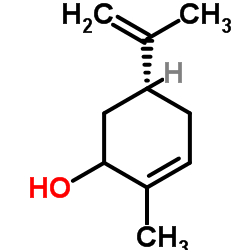Preventing biofilm formation: promoting cell separation with terpenes.
Carla C C R de Carvalho, M Manuela R da Fonseca
Index: FEMS Microbiol. Ecol. 61(3) , 406-13, (2007)
Full Text: HTML
Abstract
Both carveol and carvone were effective in dispersing Rhodococcus erythropolis cells that were being stimulated to aggregate by the presence of organic solvents. The two terpenes influenced the fatty acid composition of the cell membrane, decreasing the percentage of fatty acids with more than 16 carbon atoms, and thus cell hydrophobicity, and also the degree of saturation of the fatty acids. In the presence of 250 micromol of terpene, the volume of biofilm was reduced by one third in comparison with biofilms in the absence of terpenes. The percentage of aggregated cells was also found to depend on carvone concentration during the bioconversion of carveol to carvone, in a membrane reactor. The extent of cell aggregation decreased from 90% to 10% when carvone concentration reached ca. 48 mM in the organic phase.
Related Compounds
| Structure | Name/CAS No. | Molecular Formula | Articles |
|---|---|---|---|
 |
(-)-Carveol
CAS:99-48-9 |
C10H16O |
|
Inhibition by menthol and its related chemicals of compound ...
2013-03-14 [Life Sci. 92(6-7) , 359-67, (2013)] |
|
Chemical composition and larvicidal activity of essential oi...
2012-05-01 [Parasitol. Res. 110(5) , 2023-32, (2012)] |
|
A glandular trichome-specific monoterpene alcohol dehydrogen...
2010-08-01 [Phytochemistry 71(11-12) , 1264-9, (2010)] |
|
Hydroxylation of limonene enantiomers and analogs by recombi...
2001-03-01 [Arch. Biochem. Biophys. 387(1) , 125-36, (2001)] |
|
Distinct effects of carvone analogues on the isolated nerve ...
2010-10-25 [Eur. J. Pharmacol. 645(1-3) , 108-12, (2010)] |